|
Aviation Charter is a mainstay at Eden Prairie’s Flying
Cloud Airport, where it has been providing flight and aircraft services for
more than 25 years.
While the 10-plane, 45-employee company offers flights,
fueling and repair services, the life-saving part of Aviation Charter’s
business differentiates it from most other aviation-related companies.
The firm has been working with LifeSource – a Minneapolis-based
non-profit that manages organ, eye and tissue donations – almost for as long as
it’s been in business, said Shirley Wikner, the CEO of Aviation
Charter.
The donation-related flights account for about 25 percent of
Aviation Charter’s business and the relationship with LifeSource is thriving.
The flights occur whenever a donor organ becomes available
and a match is confirmed. Time is of the essence. Heart and lung transplants,
for example, need to take place within six hours after the recovery of a
donated organ.
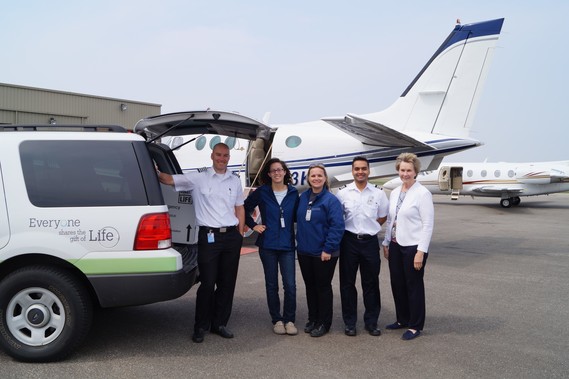 Shirley Wikner, on the right, with a flight crew from Aviation Charter set to depart on an organ and tissue procurement flight.
The coordination of organ acquisition and operating room schedules regularly lead to nighttime flights in and out of Flying Cloud.
Wikner knows that those after-hours flights can generate complaints to the airport from residents who live nearby.
“A lot of what we do is community service, and that’s different than the typical charter where you’re headed for a vacation,” Wikner said. “We’re not trying to be disruptive.”
Most of the flying is in the region served by LifeSource – Minnesota,the Dakotas and a portion of Western Wisconsin – but Aviation Charter also flies to other areas for organ donations.
On a recent weekday, an Aviation Charter flight had just returned from Tulsa, Oklahoma to transport a donated organ.
While the recipients get a new lease on life, Wikner also sees the donor process aiding families that have lost a loved one.
“The healing process is so much faster when a family knows that at least there was some good that came out of a tragedy,” she said.
In the region served by LifeSource, 64 percent of adults are registered as donors, which is higher than the national figure of 54 percent.
The need for donor matches remains high. Nationally, an average of 22 people die each day waiting for an organ donation.
Information about how to register as an organ donor is available here. In addition to the driver’s license designation, the state of Minnesota also allows residents to register as organ donors when they purchase hunting or fishing licenses.
 Grab your seven strongest friends and support a good cause by participating in the fifth annual Plane Pull competition on Sept. 8.
Teams of up to eight people will compete to see who can pull a Delta jet 25 feet in the shortest time. To participate, each team is asked to raise $1,000 in pledges for Special Olympics Minnesota. Winners walk away with bragging rights for the entire year.
The event will once again take place at Minneapolis-St. Paul International Airport (MSP) at 7109 Longfellow Ave., Minneapolis. Registration begins at 8 a.m., and the event will begin at 9 a.m. To register your team, visit planepullmn.org.
Can't get a team together? There are many volunteer opportunities at the event as well, including timers, cheerleaders, recorders and registration assistants.
This family-friendly event is presented by Minnesota law enforcement agencies as part of their year-round Law Enforcement Torch Run fundraising efforts. Co-sponsors include HMSHost, EndeavorAir, Delta, and the MSP Airport Police Department.
For more information visit planepullmn.org.
|
 For the second year in a row, Minneapolis-St. Paul International
Airport received recognition for its efficient operation.
The Air Transport Research Society (ATRS) presented MSP with the
Award of Excellence this month, recognizing efficiency in productivity and
operations, unit-cost competitiveness and comparisons of airport charges.
MSP was named the top North American Airport for efficiency
excellence in 2018 in the 25 million to 40 million-passenger-per-year category.
MSP accommodated 38 million passengers last yeaer, surpassing the previous
record of 37.6 million from 2005.
The methodology for the ATRS award takes into account labor and
other non-capital costs, and factors such as aircraft movements, passenger
numbers and other revenue sources.
The ATRS is an industry group that was formed in 1995 as part of
the World Conference on Transport Research Society. The ATRS exchanges research
ideas and results, and enhances research capability for multi-national and
multi-disciplinary issues related to air transportation.
|
 Lake Elmo Airport will host Airport Aviation Day on Sunday
Aug. 12, from 8 a.m. to 1 p.m.
The event, sponsored by the Experimental Aircraft
Association (EAA) Chapter 54, will be held at Valter’s Aviation, the fixed-base
operator at Lake Elmo.
A pancake breakfast will be served, antique airplanes and
cars will be on display, and there are activities for children. The suggested
donation is $7 for adults and $3 for children under age 12.
More information is available on this calendar page.
|
(Editor’s note: Following is the sixth in a series of articles regarding how the Metropolitan Airports Commission came into being 75 years ago, and how the commission’s airport system has evolved over the decades.)
As the controversy about a new site for an
airport in Ham Lake faded, the MAC pushed into the 1970s with an eye toward
well-managed growth.
Airlines continued to modernize their fleets and add destinations, while passenger counts at MSP grew steadily. The four-million-passenger
level predicted for 1975 had been surpassed in 1967 and the MAC worked with the
airlines to add gates at the terminal and hangars on the airfield.
In the early 1970s, MAC leaders made several accommodations
for the airport’s growing number of passengers. In November of 1970, as the
Vietnam War continued, the “Servicemen’s Center” opened at MSP. Volunteers
staffed the center 24 hours a day. In its first year, the center served more
than 18,000 military personnel passing through the airport.
The airport also continued to reach out to community members
upset about airport noise. In 1971, the MAC hired Claude Schmidt as its first
director of environment and noise abatement.
In a news story about his new post, Schmidt said he hoped to
reduce the number of military flights over time, re-route flights over
less-populated areas and reduce nighttime engine run-ups, which are used to
test engines.
The MAC’s noise program, a pioneering effort among U.S.
airports, attracted increasing amounts of media attention throughout the 1970s.
The Metropolitan Aircraft Sound Abatement Council met regularly, looking for
ways to reduce noise above residential areas.
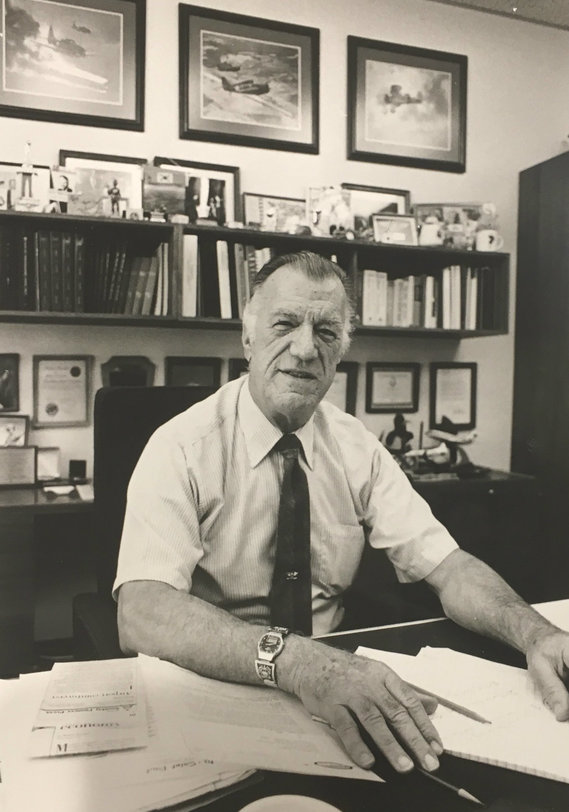 Ray Glumack, the MAC's executive director from 1975 to 1985.
MSP’s broader growth plan hit a snag when the 1973 oil crisis arrived. Oil-producing countries in the Middle East set an embargo against exports to the US, a response to U.S. support of Israel in the Yom Kippur War.
Ray Glumack, who at the time was the director of operations for the MAC, told the Minneapolis Star in November 1973 that flights at MSP were being cut back substantially because of the oil crisis. Federal authorities had asked the airlines to reduce aircraft fuel consumption by 25 percent from 1972 levels.
The MAC maintains control of the airports; Hamiel arrives
The idea of moving the airport to Ham Lake in the late 1960s had brought attention to the airport’s operations and planning. However, the airport’s revenues were dedicated to maintaining MSP operations and expanding the current site as needed -- not acquiring another location.
Some legislators and the Metropolitan Council, the regional planning group in the Twin Cities, saw a need for a change.
In 1972, the Metropolitan Council began a push to gain more control over the MAC, along with the area’s transit system and sewer board.
The Met Council wanted the authority to appoint the chairs and members of all three agencies, and authority to review their capital and operating budgets. The Council also wanted more control over plans for a new airport.
In 1973, the Met Council’s efforts to take control of the MAC failed for lack of support from legislators. One change that did become reality involved the MAC’s board of commissioners, which was eventually expanded to include representatives from suburban areas where any new airport would be located.
In 1975, Glumack became the MAC’s executive director, succeeding Henry Kuiti, who had held the post since 1960.
Glumack’s tenure included guiding the airport through the era of airline deregulation and focusing more on the MAC’s noise program, which included hiring Jeff Hamiel in 1977 as manager of noise abatement and environmental affairs.
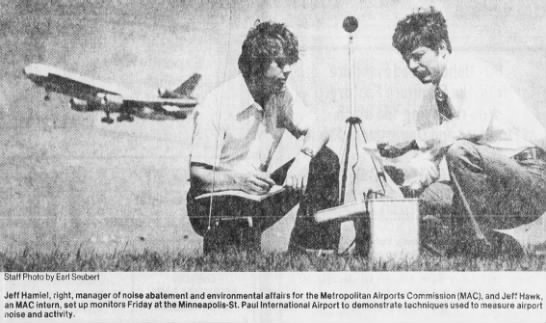 A Minneapolis Star photo and cutline from 1977.
During the 1970s and into the 1980s, the airport implemented more than 50 strategies to reduce noise. One procedure to reduce noise in 1974 involved having arriving commercial flights approach MSP at a steeper angle, reducing noise for residents several miles from the airport, but not those neighborhoods closest to MSP.
“Some (procedures) worked, some didn’t,” Hamiel said. “But we worked constantly to improve the situation.”
Security screening comes to MSP
Prior to the 1970s, American airports had only minimal security measures in place, and there were no security screenings prior to getting on a plane.
The arrival of security screening stemmed from a rash of hijackings in American airspace, with 159 events from 1961 to the end of 1972.
The majority of those occurred in the 1968-72 timespan, when hijackings to Cuba became increasingly common.
The hijackers were often seeking political asylum in Communist Cuba, or were armed with guns or explosives and seeking to extort money from the airlines. The hijackings typically did not end in tragedy or mass casualties.
The airlines, meanwhile, feared that passengers would be more upset by metal detectors and a delay at the airport than the rare midair diversion of a hijacked flight.
The uneasy tolerance of hijacking ended in November, 1972, when a Southern Airways flight was taken over by three hijackers. The hijackers threatened to fly the plane into a nuclear reactor at Oak Ridge National Laboratory in Tennessee.
Early in 1973, the FAA began requiring security screening of all passengers and their carry-on bags. Airlines controlled the contracts for the operation of the checkpoints. Passengers quickly learned that they needed to build in extra time prior to their flight’s departure to clear security.
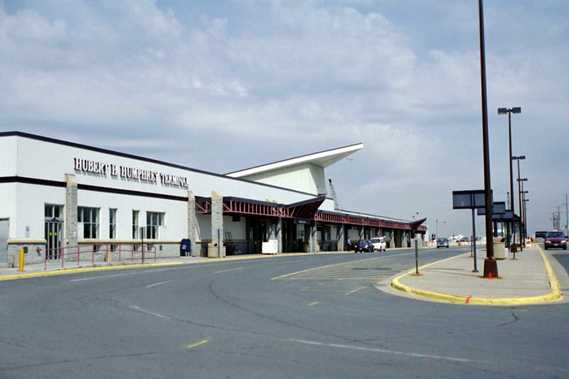 The original Humphrey Terminal in the late 1970s. The building previously served as a United Airlines hangar.
The Humphrey Terminal’s early days
In 1975, the MAC bought United Airline’s six-year-old hangar with its paraboloid roof and converted it into what would later be named the Hubert H. Humphrey Charter Terminal. It was expected to serve 100,000 passengers per year.
The new international charter terminal was dedicated in 1976. The facility could handle three charter flights at a time, and passengers were transported to the main terminal by a shuttle bus that used a tunnel under the airfield.
The 48,000-square-foot terminal replaced the space at the main terminal that had housed U.S. Customs and arrivals of international charter flights. At the time, MSP served about 60 international charter flights per month.
In August of 1977, the Minnesota Zoo’s two new Beluga whales were unloaded from a plane at the charter terminal, a process that took more than an hour. The whales, transported to Minnesota from Churchill, Canada, on Hudson Bay, were among the zoo’s top attractions in its early years.
This original charter terminal would be replaced in 2002 by a much more modern and spacious building.
Airline deregulation comes to MSP; Republic Airlines forms
Prior to 1978, the federal government controlled airfares, routes and market entry of new airlines. The Airline Deregulation Act of 1978 eventually brought dramatic change to the airline industry, including increased competition and more airlines flying out of MSP and other airports across the nation.
 The North Central Airlines hangar in the 1970s.
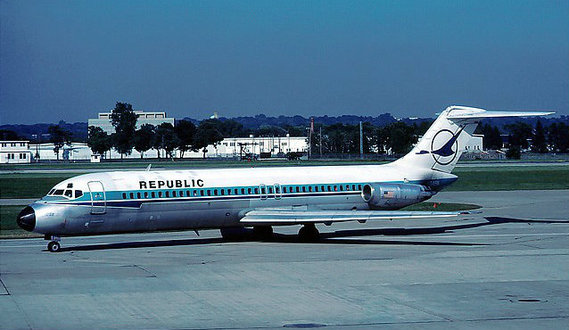 A Republic Airlines DC-9 at MSP in the early 1980s.
The first merger of airlines after deregulation occurred in 1979. North Central Airlines and Southern Airways merged to form Republic Airlines, with headquarters at MSP.
Just prior to deregulation, MSP was served by eight mainline carriers and four commuter airlines, Glumack told the Minneapolis Star.
Soon after deregulation in 1978, MSP had 15 major carriers and eight commuter airlines serving the market, with 13 more waiting in the wings and four international airlines looking for access to gates, Glumack said.
Republic Airlines had a large presence at MSP, due to North Central’s history at the airport. But the airline’s largest hub was located in Detroit. Republic also bought out Hughes Airwest in 1980, making the new airline the largest in the country as measured by the number of airports served.
Jet fuel prices had doubled in 1979, but the after-effects of deregulation were playing a large role in the airline market.
Northwest Airlines, which would merge with Republic later in the 1980s, announced a new, broader domestic schedule, serving 20 new domestic markets, and ratcheted up its international destinations as well. That included the first trans-Atlantic passenger service through Detroit and New York to Copenhagen and Stockholm in 1979.
Passenger service to Glasgow soon followed and on June 2, 1980, Northwest flew the first Twin Cities-to-London (Gatwick) direct flight on a Boeing 747.
Sources:
MAC archive materials.
Minneapolis Star newspaper articles.
Minnesota Historical Society archives.
“Northwest Airlines: The first 80 years,” by Geoff Jones.
“America’s North Coast Gateway,” by Karl Bremer.
Board Meetings
Business Opportunities
Career Opportunities
General Aviation Airport Information
MSP Aircraft Noise Information
MSP Airport
|